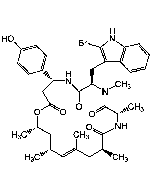Cookie Policy: This site uses cookies to improve your experience. You can find out more about our use of cookies in our Privacy Policy. By continuing to browse this site you agree to our use of cookies.
AdipoGen Life Sciences
Cucurbitacin E
As low as
40
CHF
CHF 40.00
In stock
Only %1 left
AG-CN2-0474-M0011 mgCHF 40.00
AG-CN2-0474-M0055 mgCHF 140.00
AG-CN2-0474-M02525 mgCHF 580.00

| Product Details | |
|---|---|
| Synonyms | Cuc E; α-Elaterin; α-Elaterine; NSC106399; BRN2343323 |
| Product Type | Chemical |
| Properties | |
| Formula |
C32H44O8 |
| MW | 556.7 |
| CAS | 18444-66-1 |
| Source/Host Chemicals | Isolated from Cucumis melo L. |
| Purity Chemicals | ≥98% (HPLC) |
| Appearance | Off-white powder. |
| Solubility | Soluble in DMSO. |
| Identity | Determined by 1H-NMR. |
| InChi Key | NDYMQXYDSVBNLL-MUYMLXPFSA-N |
| Smiles | [H][C@@]1([C@H](O)C[C@@]2(C)[C@]3([H])CC=C4[C@@]([H])(C=C(O)C(=O)C4(C)C)[C@]3(C)C(=O)C[C@]12C)[C@@](C)(O)C(=O)\C=C\C(C)(C)OC(C)=O |
| Shipping and Handling | |
| Shipping | AMBIENT |
| Short Term Storage | +4°C |
| Long Term Storage | -20°C |
| Handling Advice |
Keep cool and dry. Protect from light. |
| Use/Stability | Stable for at least 2 years after receipt when stored at -20°C. |
| Documents | |
| MSDS |
 Download PDF Download PDF |
| Product Specification Sheet | |
| Datasheet |
 Download PDF Download PDF |
Description
- Potent actin depolymerization inhibitor. Shown to have a different mechanism of action compared to jasplakinolide (Prod. No. AG-CN2-0037), binding to a different site.
- Binds specifically to filamentous actin (F-actin) forming a covalent bond at residue Cys257, stabilizing F-actin without affecting actin polymerization or nucleation. Does not bind to monomeric actin (G-actin).
- Immunomodulator with anti-inflammatory and anti-tumorigenic properties in a range of cancer cell lines, mediated by its action on the cellular cytoskeleton, on mitotic pathways as well as on cellular autophagy.
- Shown to induce apoptosis, autophagy and cell cycle arrest at G2/M. Inhibits tumor angiogenesis through Jak-STAT3 signaling pathway, suppresses cell migration and invasion, and inhibits NF-κB nuclear translocation.
- Antioxidant and potential neuroprotective compound with potential neurodegenerative properties.
Product References
- Cucurbitacin E-induced disruption of the actin and vimentin cytoskeleton in prostate carcinoma cells: K.L. Duncan, et al.; Biochem. Pharmacol. 52, 1553 (1996)
- Cucurbitacin glucosides: antioxidant and free-radical scavenging activities: T. Tannin-Spitz, et al.; BBRC 364, 181 (2007)
- Direct interaction of Cucurbitacin E isolated from Alsomitra macrocarpa to actin filament: K. Momma, et al.; Cytotechnology 56, 33 (2008)
- Cucurbitacin E, a tetracyclic triterpenes compound from Chinese medicine, inhibits tumor angiogenesis through VEGFR2-mediated Jak2-STAT3 signaling pathway: Y. Dong, et al.; Carcinogenesis 31, 2097 (2010)
- Cucurbitacin E Induces G(2)/M Phase Arrest through STAT3/p53/p21 Signaling and Provokes Apoptosis via Fas/CD95 and Mitochondria-Dependent Pathways in Human Bladder Cancer T24 Cells: W.W. Huang, et al.; Evid. Based Complement Alternat. Med. 2012, 952762 (2012)
- The natural product cucurbitacin E inhibits depolymerization of actin filaments: P.M. Soerensen, et al.; ACS Chem. Biol. 7, 1502 (2012)
- Cucurbitacin E inhibits breast tumor metastasis by suppressing cell migration and invasion: T. Zhang, et al.; Breast Cancer Res. Treat. 135, 445 (2012)
- Cucurbitacin E exhibits anti-inflammatory effect in RAW 264.7 cells via suppression of NF-κB nuclear translocation: J. Qiao, et al.; Inflamm. Res. 62, 461 (2013)
- Cucurbitacin E as inducer of cell death and apoptosis in human oral squamous cell carcinoma cell line SAS: C.M. Hung, et al.; Int. J. Mol. Sci. 14, 17147 (2013)
- Cucurbitacin E has neuroprotective properties and autophagic modulating activities on dopaminergic neurons: A.M. Arel-Dubeau, et al.; Oxid. Med. Cell Longev. 2014, 425496 (2014)
- Inducement of mitosis delay by cucurbitacin E, a novel tetracyclic triterpene from climbing stem of Cucumis melo L., through GADD45γ in human brain malignant glioma (GBM) 8401 cells: Y.C. Hsu, et al.; Cell Death Dis. 5, e1087 (2014)
- Cucurbitacin E Induces Autophagy via Downregulating mTORC1 Signaling and Upregulating AMPK Activity: Q.B. Zha, et al.; PLoS One 10, e0124355 (2015)






